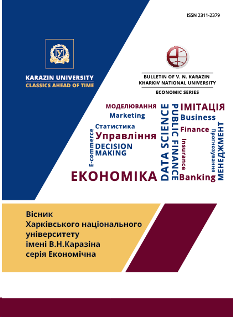ЕФЕКТИ ІННОВАЦІЙ НА ПРОДУКТИВНІСТЬ ПРАЦІ В КОМПАНІЇ
Анотація
У статті розглядаються ефекти впливу інновацій на продуктивність праці, якість роботи та трудові контракти. Інновації – це основні фактори зростання продуктивності праці. Збільшення інновацій забезпечує вивільнення робочої сили у низько технологічних галузях економіки, перерозподіл робітників на користь високотехнологічних секторів економіки з високою частиною доданої вартості, а також головного джерела покращення добробуту населення та розвитку суспільства. Методологія дослідження включає застосування міждисциплінарного підходу, заснованого на використанні інституціонального аналізу, управління людськими ресурсами та методу економічної компаративістики. Систематизація основних підходів, включаючи системну інноваційну систему, постійну організацію, концепцію дифузії інновацій тощо розширює об'єкт дослідження та дозволяє знаходити нові напрямки у вивченні взаємозалежності між інноваціями та продуктивністю праці. Дослідження економічних показників державних витрат на НДДКР, витрат на інновації, зайнятість у виробництві середніх та високотехнологічних технологій та високотехнологічних послуг підтверджує зменшення державних витрат на НДДКР. Останні дослідження підкреслюють основну трансформацію у світі праці з точки зору ринку праці, соціального діалогу та умов праці, заробітної плати та доходів та впливу на середній клас.Сильні інститути відіграють значну роль у процесі накопичення знань, створенні добре функціонуючої ринкової системи, розвитку інституцій та інфраструктури. Вони повністю забезпечують високу зайнятість та динамічне функціонування ринку праці. Розвиток інформаційних технологій сприяє середньорічному зростанню продуктивності праці в цілому в країнах, що розвіваються. Запропоновано напрямки передумов інноваційного розвитку та формування партнерських відносин та зав’язків між освітою, бізнесом, наукою та інноваціями.
Завантаження
Посилання
Lundwall, B. (2007). National innovation systems – analytical concept and development tool. Journal Industry and Innovation, 14, 1, 95-119.
Bathelt, H., Cohendet, P., & Henn, S. (2017). The Elgar companion to innovation and knowledge creation. Edward Elgar Publishing.
Fagerberg, J. (2007). Mission (im)possible? The role of innovation (and innovation policy) in supporting structural change & sustainability transitions. Working Papers on Innovation Studies 20180216. Centre for Technology, Innovation and Culture, University of Oslo. Retrieved from https://ideas.repec.org/p/tik/inowpp/20180216.html.
Kulikov, G. (2008). Ways To Regulate Wages in Ukraine. Labor and wages, 29, 4-6.
Bogliacino, F., Pianta, M. (2009). The Impact of Innovation on Labour Productivity Growth in European Industries: Does It depend on Firm’s Competitiveness Strategies? IPTS Working Paper on Corporate R&D and Innovation, No. 13. Retrieved from https://pdfs.semanticscholar.org/59fa/2a5a07c703186ecdc4a949a88b0988ece507.pdf.
Preenen, P. T. Y., Vergeer, R. A., Kraan, K. O., & Dhondt, S. (2015). Labour productivity and innovation performance: The importance of internal labour flexibility practices. Economic and Industrial Democracy. doi: 10.1177/0143831X15572836.
Dykha, M., Tanasiienko, N. and. Kolisnyk, G. (2017). Ensuring of Labor productivity growth in the context of investment and innovation activity intensification. Problems and Perspectives in Management, 15(4), 197-208.
Majcen, B., Radosevic, S., Rojec, M. (2009), Nature and Determinants of Productivity Growth of Foreign Subsidiaries in Central and East European Countries. Economic Systems, 33(2), 168-184.
Matteo, C., Simone, G., Mancuso, P. (2012). ICT Capital and Labour Productivity Growth: A Non-Parametric Analysis of 14 OECD Countries. Retrieved from https://mpra.ub.uni-muenchen.de/68642/.
Vaughan-Whitehead, D., Rosalia Vazquez-Alvarez, R., Maître, N. (2016). Is the world of work behind middle-class erosion? DOI: 10.4337/9781786430601.00006.
Berg, J. (ed.) (2015). Labour Markets, Institutions and Inequality: Building just societies in the 21st century. Retrieved from https://www.elgaronline.com/view/edcoll/9781784712099/9781784712099.xml.
Grishnova, O., Kostenko, T. (2014). Information technologies within the system of novel factors of labour productivity growth: trends and paradoxes. Current Economic Problems, 2 (152), 462-468.
Economic Activity of Population in Ukraine 2018 (2019). Retrieved from https://ukrstat.org/en/druk/publicat/kat_e/2019/zb/zb_lfs_2018.pdf.
European Innovation Scoreboard (2009). Comparative Analysis of Innovation Performance. (2009). Retrieved from http://www.proinno-europe.eu/metrics.
Denisova, A. (2005). Modern problems of system analysis. Informational basics. SPb. Publishing House of the Polytechnic University. (in Russian)
Gianella, C., Tompson, W. (2007). Closing the Productivity Gap in Ukraine. Further privatization and competition enhancing reform will stimulate greater dynamism. OECD Economies Department Working Papers. [Online], No.57. Retrieved from http://www.oecd.org.
Ease of Doing Business in Ukraine. (2019). Retrieved from https://tradingeconomics.com>Ukraine.
Innovation Performance Review of Ukraine. (2013). Retrieved from https://www.unece.org/fileadmin/DAM/ceci/publications/icp7.pdf.
Nosova, O. (2018). Economic modeling of regional development in Ukraine. Mind Journal, 6, 1-18. Retrieved from https://mindjournal.wseh.pl/ru/articles/nomer-62018.html.
Viens, A. (2019). The 10 most innovative Economies in 2019. Which countries snag this year’s top spots, and how much are they investing in R&D? The World’s Most Innovative Economies. Retrieved from https://www.visualcapitalist.com/the-10-most-innovative-economies-in-2019/.
State Statistics Service of Ukraine. Retrieved from http://ukrstat.gov.ua.
Ukraine IT industry overview. (2019). Retrieved from https://outsourcingreview.org/outsourcing-playbook/it-industry-overview/.
World Development Report. (2005). Retrieved from http://siteresources.worldbank.org/INTWDR2005/Resources/complete_report.pdf.
Saha, D., Kravchuk, V. (2015). The Industrial Sector of Ukraine: Trends, Challenges and Policy Options. Retrieved from http://www.beratergruppe-ukraine.de.
Rusnak, A., Prokhorchuk, S. (2018). Innovative Capacity of Ukraine’s Economy in the International Context. Baltic Journal of Economic Studies, 4, 3. Retrieved from https://doi.org/10.30525/2256-0742/2018-4-3-264-270.
Muthusamy, V., Abdul Rasid, S.Z. (2018). Leveraging Human Capital Development for Sucessful Labour Mix Rationalizatioin and Productivity Growth. International Journal of Innovation and Business Strategy (IJIBS). University Technology Malaysia, 10, 2, 46-58.
Statistical Yearbook: Research and Innovation in Ukraine 2011 (2012). Retrieved from http://www.ukrstat.gov.ua/.
Competitive Industrial Performance Report 2018. (2019). Retrieved from https://www.unido.org/sites/default/files/files/2019-05/CIP_Report_2019.pdf.
Ukraine Competitiveness Rank. (2019). Retrieved from https://tradingeconomics.com/ukraine/competitiveness-rank.
Rodrik, D. (2018). What Do Trade Agreements Really Do? Journal of Economic Perspectives, 32, 2, 73-90.

